Have you ever had a yellow-bellied woodpecker whiz right past your head? Well, I have not once, not twice, but three times in one day! Every spring, with the return of several migrating bird species to the area, comes the arrival of the yellow-bellied sapsucker. You definitely know when they are back, because of their distinctive sounds. This not only includes their calls but, their irregular drumming as well. One day in late April of this year, I heard their easily recognizable sounds and grabbed my camera. I could tell there were two males in the area because there were two separate calls. The whole day also entailed territorial drumming on numerous objects. Not only do these birds use trees, but anything that they find that suits their fancy. This includes human-made materials such as street signs, mailboxes, flashing, etc. This drumming sound is amplified on these objects and this helps to get the message out that this is their territory. The sapsuckers don’t seem to suffer any negative effects from doing so. My two male visitors decided that selected trees, our wooden garage, and shed would make do and this went on all day long. I’m glad they didn’t decide to do this on the mailbox. That would have been quite a racket! Between drumming sessions, there was a lot of boisterous flying and calling from these birds.

This brings me back to these birds whizzing by my head, while I was out in the open and in the woods. I didn’t mind so much, because I had my camera with me and my goal was to get as many photographs of these energetic and entertaining birds as possible. I only wish I had caught sight of a female, too. It was too early in the season for their arrival. There is time yet and I hope to have my chance this summer. I missed out last year on photographing and recording a nest cavity that I had found in the woods during the summer. I would have had to stake out a spot deep in the underbrush, in the company of several bugs. I felt I had already donated enough of my blood to the local mosquito population. I had just about enough of that. Also, it would have been too hot and humid to sit there with all my bug gear on. Hopefully, this year, I will have a second chance. We will just have to see.
I would like to share a few interesting facts about the yellow-bellied sapsucker Sphyrapicus varius as well as a few photographs from my day with these exuberant birds.
Yellow-bellied Sapsucker Size & Shape
Yellow-bellied sapsuckers are medium-sized woodpeckers with a relatively short, straight bill. When extended, the long wings reach the tip of a stiff, pointed tail when the bird is at rest. Sapsuckers will often hold their crown feathers to form a sort of peak at the back of their heads.
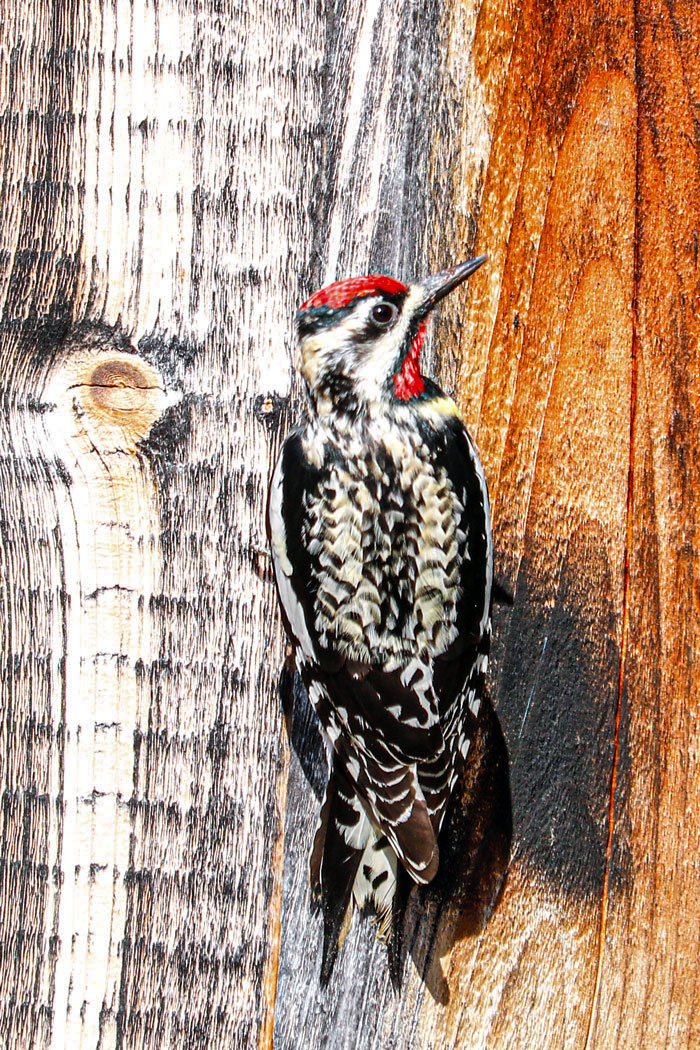
Yellow-bellied Sapsucker Colors & Patterns
Yellow-bellied sapsuckers are mostly black and white in color with bold patterns on their faces. Both sexes have red-colored foreheads. The throat and chin can be used to distinguish between the two sexes, as they are white in the female and red in the male. When the wings are folded, you will see a long white stripe. There are also bold black-and-white stripes that curve from the face toward a black chest shield and white or yellowish-colored underparts.

Here is an updated photograph of a female yellow-bellied woodpecker. I figured they would take advantage of this birch tree with the drilled holes and with a little time and patience, I knew the female would make an appearance eventually. As you can see, she shares the same coloring as males, except for the coloring on the chin and neck.
Yellow-bellied Sapsucker Habitat
Yellow-bellied sapsuckers can be found in both hardwood and conifer forests up to about 6,500 feet elevation. They often nest in areas with small trees such as aspens and spend their winters in open woodlands. They seem to enjoy our polar and birch trees here on our property.

Yellow-bellied Sapsucker Behavior & Diet

You will find yellow-bellied sapsuckers perched upright on trees. They lean their tail similar to other woodpeckers. Sapsuckers spend their time drilling holes in tree bark, usually done so in neatly spaced rows. They periodically return to feed on the sap that oozes out, as well as on the insects that are attracted and get trapped in the sticky substance. These birds also eat bits of cambium and other tree tissues. Besides drilling sap wells, they also obtain insects from tree trunks in a more typical woodpecker fashion and also go about catching insects in the air. Berries and fruits are eaten during all of the seasons and birds may focus their attention on wild fruiting trees in winter. Occasionally, you may observe sapsuckers visiting bird feeders for suet, but they typically don’t visit bird feeders.
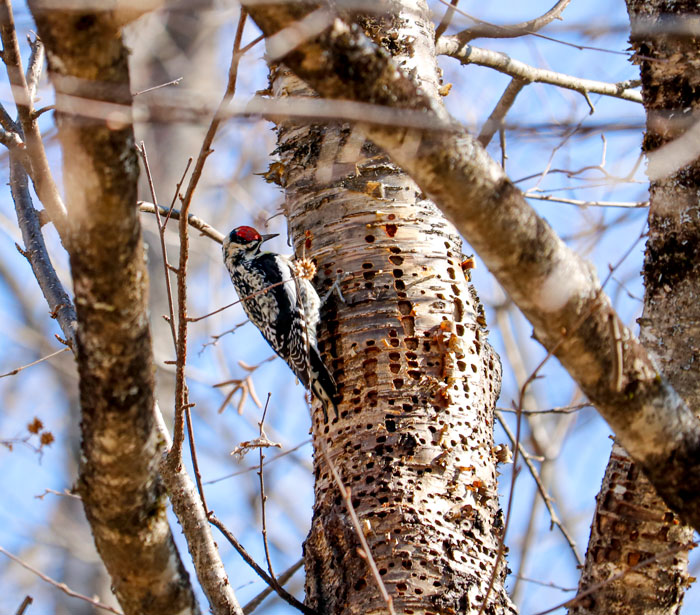
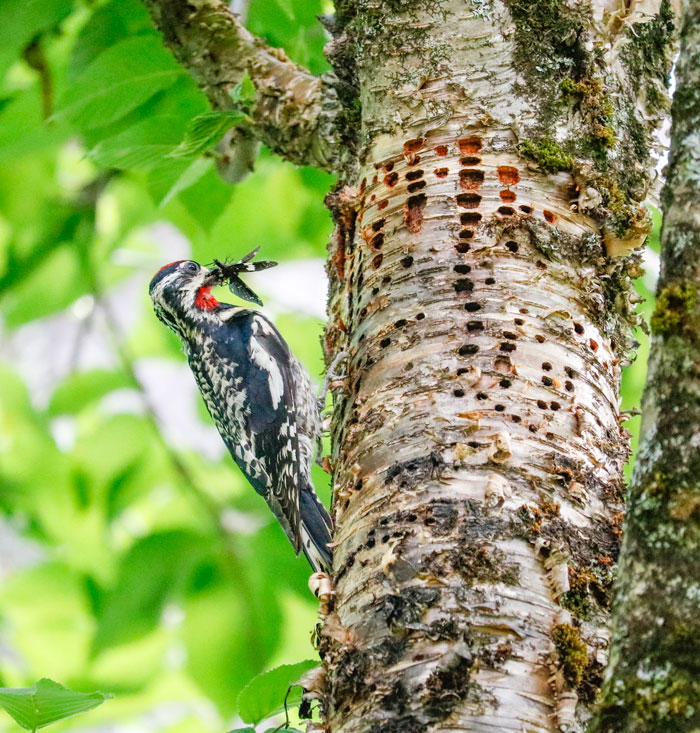
Yellow-bellied Sapsucker Call & Drum
The signature call of the yellow-bellied sapsucker is a scratchy, nasal mewing that is often repeated. These birds also have a squealing call as a repeated quee-ah, quee-ah, that is for territorial purposes and is often heard during the breeding season. They will make a waa call when disturbed or to alert others of potential danger.
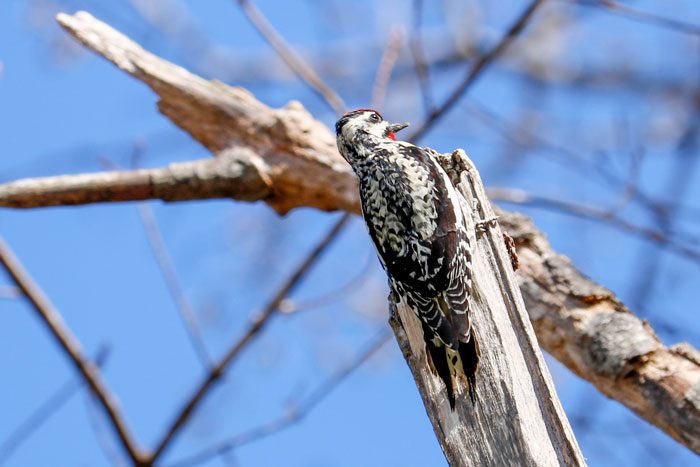
Similar to other sapsuckers, the yellow-bellied sapsucker’s drumming is slower and more irregular than other types of woodpeckers. Its stuttering rhythm almost sounds like somebody tapping out morse code. In addition to trees with good sound quality, Yellow-bellied sapsuckers also drum on metal surfaces such as street signs or chimney flashing, in order to better amplify their territorial messages. Most drumming is done by the males during the breeding season.
Yellow-bellied Sapsucker Nesting
Males will arrive at potential breeding areas before the females. Courtship behavior includes displays of pointing bills up to show off a colored throat patch and ritualized tapping at nesting sites. Nests are constructed as cavities in trees, that include deciduous trees such as aspen, poplar, and birch, six to sixty feet above the ground. These birds will use the same tree in consecutive years, but rarely the same nesting hole. They favor trees that are affected by tinder fungus, which softens heartwood while leaving the outer part of the trunk firm. Both sexes will help to excavate.
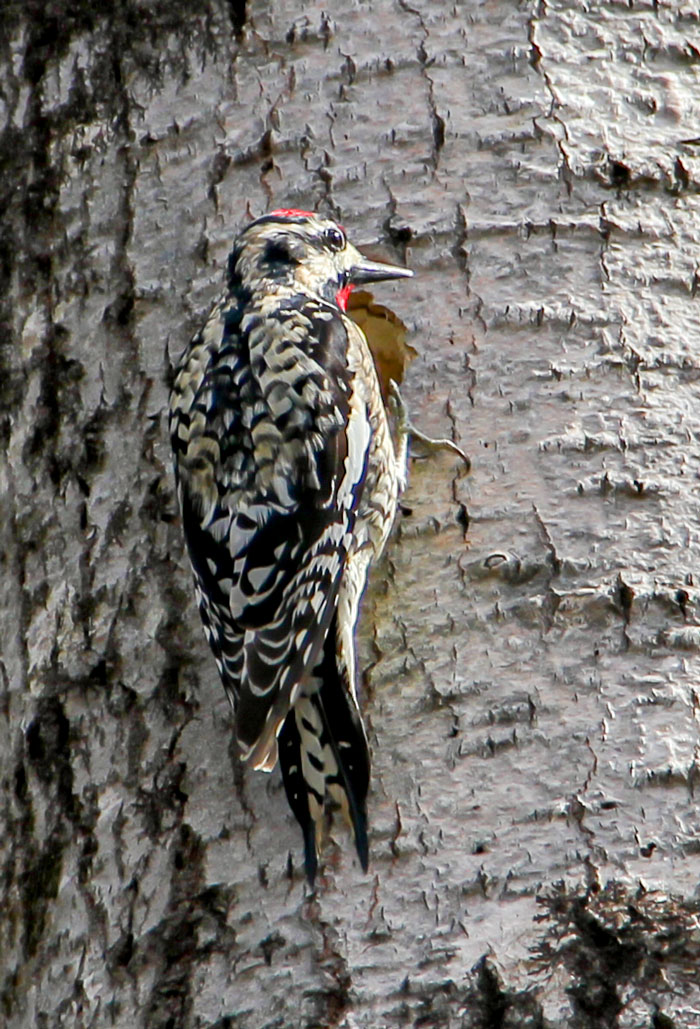
Both parents feed the young, bringing them a variety of insects, sap, and fruit. The young leave the nest twenty-five to twenty-nine days after hatching. Parents teach their young the sapsucking habit, then feed them for about ten days after they leave the nest. They have one brood per year.
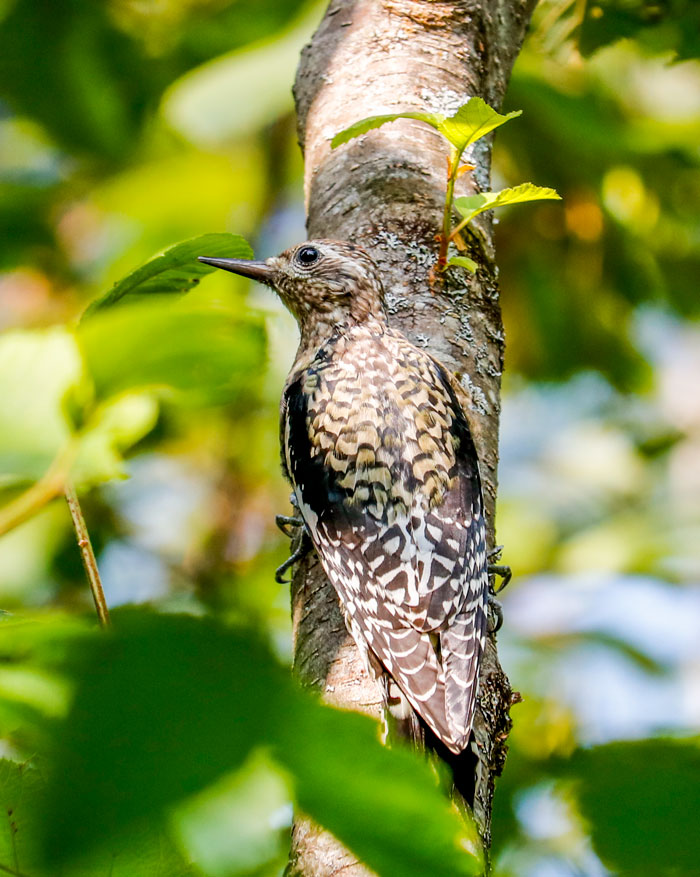
A photograph of a juvenile yellow-bellied sapsucker from this September.
Yellow-bellied Sapsucker Migration
Yellow-bellied sapsuckers are considered to be short to long-distance migrants. These birds leave their breeding range in September and early October to winter in the southern U.S., Mexico, West Indies, and Central America. They will usually come back north in May. Females will tend to migrate even farther than the males, leaving a ratio of more than three females to one male in Central America.

Thank you for reading and I hope you enjoyed learning a little about the fascinating yellow-bellied sapsucker.
Resources used for this post:
allaboutbirds.org & audubon.org
Leave a Reply